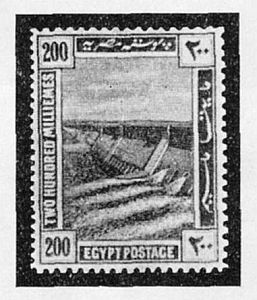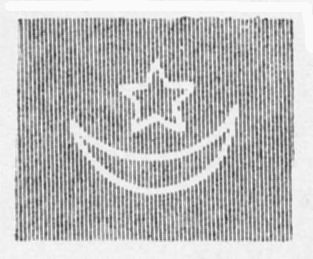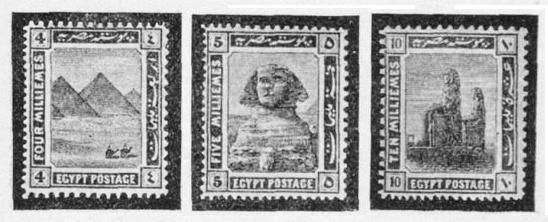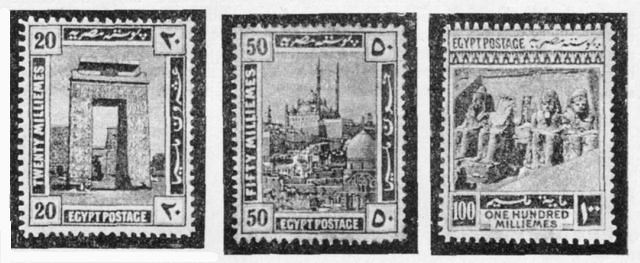Egypt stamps pre-1900.
On January 8, 1914, a handsome new series of stamps was issued in Egypt, on the anniversary day of the accession of the Khedive, Abbas II (later deposed by Sultan Hussein I). These were not of a commemorative character, but were issued on the anniversary as a compliment to the then reigning Khedive.
 The designs on the fine series of stamps are:—1 millieme, sepia: gyassas or sailing-boats on the Nile; 2m., green: Cleopatra in the garb and head-dress of the goddess Isis; 3m., orange-yellow: the Ras-el-Tin Palace in the Muhammedan quarter of modern Alexandria;
The designs on the fine series of stamps are:—1 millieme, sepia: gyassas or sailing-boats on the Nile; 2m., green: Cleopatra in the garb and head-dress of the goddess Isis; 3m., orange-yellow: the Ras-el-Tin Palace in the Muhammedan quarter of modern Alexandria; 4m., vermilion: the Pyramids of Giza; 5m., lake: the Sphinx of Giza; 10m., cobalt: the two Colossi of Amenophis III. on the banks of the Nile at Thebes;
20m., olive: the Pylon or Gateway to the Karnak Temple; 50m., lilac: the Citadel at Cairo; 100m., slate: the Rock Temple at Abû Simbel, Ipsambul;

200m., marone: the Aswân Dam, at the first cataract of the Nile.
 The watermarked paper on which they are printed includes the watermarked device is that popularly known as the "star and crescent", although modern authorities appear to agree that the Turkish symbol is not a crescent.
The watermarked paper on which they are printed includes the watermarked device is that popularly known as the "star and crescent", although modern authorities appear to agree that the Turkish symbol is not a crescent.  An Egyptian stamp with an unusual story is the postage-due stamp issued in 1898. At that time the Egyptian postal regulations charged 3 milliemes for prepaid letters but double that sum (6 milliemes) for unpaid letters, from or to non-commissioned officers and men of the Egyptian Army in garrison on the frontier, as well as at Suakim and Tokar; the same tariff was applicable to soldiers taking part in the Expedition to the Sudan.
An Egyptian stamp with an unusual story is the postage-due stamp issued in 1898. At that time the Egyptian postal regulations charged 3 milliemes for prepaid letters but double that sum (6 milliemes) for unpaid letters, from or to non-commissioned officers and men of the Egyptian Army in garrison on the frontier, as well as at Suakim and Tokar; the same tariff was applicable to soldiers taking part in the Expedition to the Sudan. In consideration of the fact that such soldiers would be most frequently in places where they would be unable to get postage stamps, the authorities decided that unpaid letters sent by them should only be liable to the single rate of 3 milliemes instead of the double rate of 6 milliemes. But as there was no postage-due stamp of 3 milliemes to use in collecting this sum, it was temporarily permitted to use a 2 millieme stamp, with half of another 2 millieme stamp divided diagonally, until the surcharged stamp 3 milliemes on 2 milliemes could be prepared and issued.

Includes edited excerpts from The Project Gutenberg e-Book of The Postage Stamp in War, by Fred. J. Melville


You have provided very valuable information about postage stamps. It is really very important, and people like to read such information.
ReplyDeleteThank you so much
Pincodezone